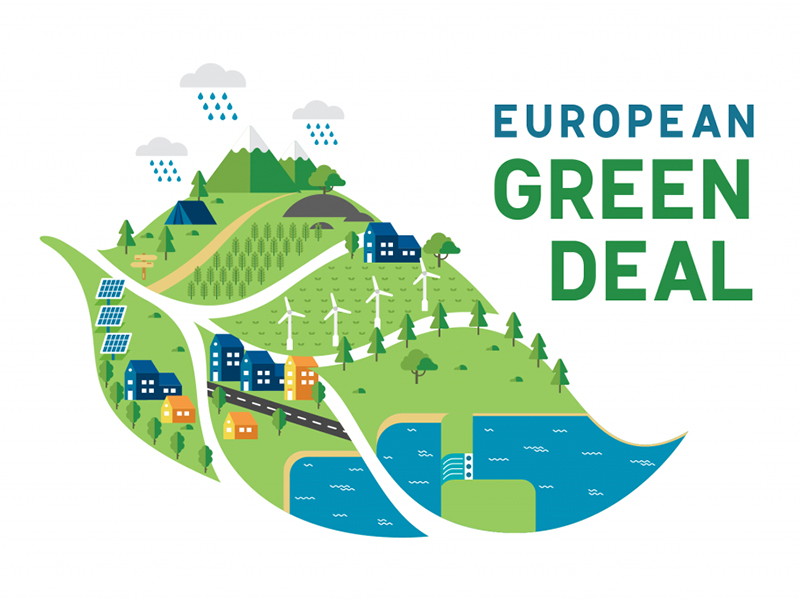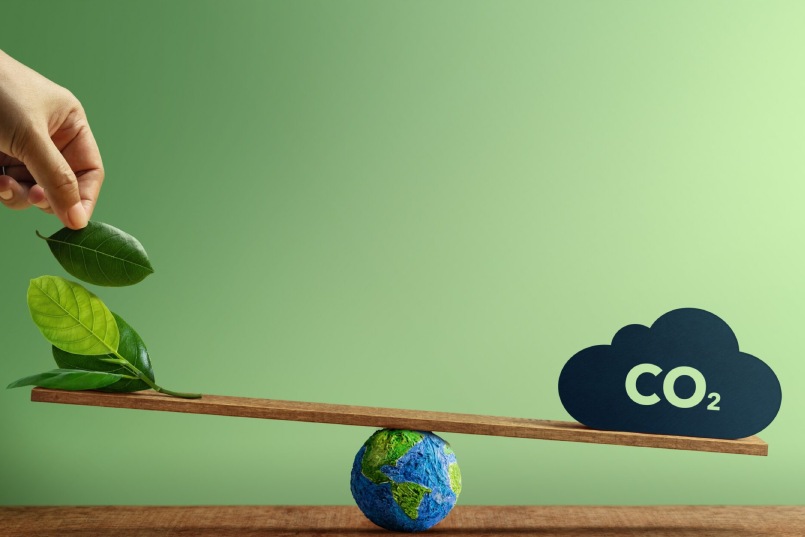What To Understand From Eu Green Deal
Oğuzhan Akyener
Abstract
Climate change became the main item in the global agenda. Accordingly, the EU Green Deal (EGD), which can be accepted as a pioneering and holistic transformation model, obtains a great importance in the current dynamics. EGD can evaluated detailed in many aspects. However, the aim of this study is only to evaluate the key features of EGD and shortly analyze the success expectancies, by reviewing the literature.
Explicably, although EGD is a comprehensive and leading model, there are huge challenges during the implementation, even within the EU. This results in bigger doubts on the attainability of net zero emission targets.
Key Words: European Green Deal, net-zero-emission, EU, climate change
- Introduction
After 30 years of vigorous efforts, climate change could be centered on the global agenda. From 1992 UNFCCC meetings to the Kyoto Protocol and from revolutionary Paris Agreement to the current COP meetings, it is obvious that nearly all the world has started/intended to do something to reduce the emissions, by taking into consideration their own respected capabilities. However, the efficiency and achievability of the current climate road maps couldn’t be satisfied.
There are many conflicted issues in the overall perceptions of the Non-Annex parties; regarding with the responsibilities, capabilities and the consequences of the transition strategies with the insufficient financial and technological backgrounds. All the parties accept the reality and the risks of the global warming, however (mainly for the Non-Annex part) growing populations, increasing energy hunger,development targets, low socio-economic and regulative profiles, unemployment rates and mainly scarce financial capabilities make negative impacts of the climate change be thrown out of focus.
In order to be able to improve the conditions through these negative perceptions, Annex2 countries made many promises regarding with the financial and technological support for the non-annex countries. Nevertheless, the results were unsatisfying. Accordingly, implementation of an exemplary transition model including all socio-economic dynamics and also (instead of forcing) attracting the undeveloped societies became more important.
From this view, as the previous successful attempts in environmental issues, EU declared a multidimensional transition model, which is EGD.
In this study, key features and success expectancies of EGD will shortly be discussed with in a literature review format.
- Key Features of EGD
Nearly in all milestones of the historical adventure in environmental and climate change issues, from 1992’s to the current time, EU has hold a leading role in all global acts and policies (Siddi, 2020).
Accordingly, EGD presented as a new exemplary model for the attention of international community, envisions an integrated system for the future that puts the fight against climate change at the center, while bearing the traces of a great deal of experience.
The European Green Deal (2019) highlights that; the main target is to transform EU’s socio-economic drivers into a sustainably growing efficient structure with zero GHG emissions in 2050 and through this vision, make EU as a global leader (The European Green Deal, 2019).
The main concept of the deal can be summarized as to:
- put a clear vision,
- prepare the demanded additional legislations and accept the climate law,
- transform the energy trends and economy with the aim of climate neutrality,
- develop the ETS and Carbon pricing systems,
- apply the carbon border adjustment mechanism,
- make green energy be beneficial for the consumers and the producers,
- mobilize the industry and specially focus on the high energy-intensive sectors,
- prevent pollution and set up a job intensive, efficient and clean model in all related areas (The European Green Deal, 2019).
- Literature Review
While making a literature review on the key features of EGD, it can be observed that, hence being the deal has a wide concept, there are too many studies focusing on different aspects of the topic.
The deal includes an assertive slogan such as: “leave no one behind (just transition)” (The European Green Deal, 2019). However, Dolge (2021) argues that, regarding with the inner dynamics of EU, for more-developed members; they have more capabilities to reduce the GHG, but for the less-developed ones, their growing targets do not fit with the emission strategies. This fact result in an unbalanced situation, although there is an expectation for not to leave anyone behind. Therefore, GHG forecast shows that 2030 reduction targets for the due lower capability states is not achievable (Dolge & Blumberga, 2021).
Ringel (2021) also supports the same situation and claims stakeholders tend to have more action regarding energy efficiency and less so with renewable energies. This is mainly due to weak binding governance and the results of the incentive mechanisms (Ringel et al., 2021). On the other hand, again Locmelis (2021) is not so positive about some of the members to able to reach the emission targets, mainly due to sectoral efficiency issues (Locmelis et al., 2021).
Conversely, Hainsch (2022) emphasizes that, although current attempts are not sufficient to reach +1,5 C target, by focusing on some key technologies (heat pumps, storage, renewables, etc.) and uploading supporting mechanisms, success can be achieved (Hainsch et al., 2022). In addition, Buckley (2021) highlights UBEM application will also be helpful to reach the due emission targets (Buckley et al., 2021) and Rivas (2021) mentions the importance of local mitigation plans for cities (Rivas et al., 2021).
Similarly, Pietzcker (2021) exploits that, tightening the ETS targets will speed up the transformation by 3–17 years in power sector and will help the net zero emission targets to be reached before 2050 (Pietzcker et al., 2021).
Regarding with the energy transition sight of the deal, instead of the mentioned offshore wind oriented strategies, Kougias (2021) argues the importance of rooftop solar systems (Kougias et al., 2021).
By referencing the biodiversity and afforestation targets of the EGD, Aggestam (2021) attempts the absence of forest bio-economy and the demand to deeply focus on this issue inside the next EU Forest Strategy (Aggestam & Giurca, 2021).
EU manages around 16% of the global trade flow. This means, EU has a huge effect on the trade balances and can use this advantage for also compelling its trade partners to decarbonize (Kettunen et al., 2020). In this respect, Eicke (2021) argues the possible risks of CBAM for EU’s biggest trade partners and how will negatively be effected from this situation (Eicke et al., 2021).
As can be understood from the literature review, there are many different concerns/proposals about the prospects/results of the EGD. Commonly, although EGD can’t be implemented accurately, is the most important model prepared up-to-date.
- Conclusion
EU is the most sophisticated and active leading structure on climate change issues in the world. From foundation, to the current situation, nearly in all UN climate actions, EU’s influence and added-values can easily be observed. Accordingly, EGD can be accepted as the most sophisticated step in this direction.
EGD is an integrated and bulletproof model to reach the net-zero-emission targets. However, although EGD is very sophisticated in the legislative/theoretical sight, in practice EU is very bulky during application. Main failures during the implementation of the common energy policies in EU, altering individualist choices of the members while facing with different problems and the current crisis after pandemic can be an excogitative prognosis to evaluate the results of the EGD.
Pandemic and eventuated energy crisis also effected the EGD targets. Although covid made GHG emissions reduce for a short term, the situation was reversed (Milan, 2020).
Consequently, as mentioned in different studies in the literature, EGD is the most important model prepared up-to-date. However, there is a big question mark in the implementation and the results of the model.
Bibliography
Aggestam, F., & Giurca, A. (2021). The art of the “green” deal: Policy pathways for the EU Forest Strategy. Forest Policy and Economics, 128, 102456. https://doi.org/10.1016/j.forpol.2021.102456
Buckley, N., Mills, G., Reinhart, C., & Berzolla, Z. M. (2021). Using urban building energy modelling (UBEM) to support the new European Union’s Green Deal: Case study of Dublin Ireland. Energy and Buildings, 247. https://doi.org/10.1016/j.enbuild.2021.111115
Dolge, K., & Blumberga, D. (2021). Economic growth in contrast to GHG emission reduction measures in Green Deal context. Ecological Indicators, 130. https://doi.org/10.1016/j.ecolind.2021.108153
Eicke, L., Weko, S., Apergi, M., & Marian, A. (2021). Pulling up the carbon ladder? Decarbonization, dependence, and third-country risks from the European carbon border adjustment mechanism. Energy Research & Social Science, 80, 102240. https://doi.org/10.1016/j.erss.2021.102240
The European Green Deal, European Commission (2019). https://doi.org/10.4324/9780080495781-12
Hainsch, K., Löffler, K., Burandt, T., Auer, H., Crespo del Granado, P., Pisciella, P., & Zwickl-Bernhard, S. (2022). Energy transition scenarios: What policies, societal attitudes, and technology developments will realize the EU Green Deal? Energy, 239. https://doi.org/10.1016/j.energy.2021.122067
Kettunen, M., Bodin, E., Davey, E., Gionfra, S., & Charveriat, C. (2020). An EU Green Deal for trade policy and the environment: development objectives. https://ieep.eu/news/green-deal-diplomacy-needs-to-be-in-focus-in-2021?utm_medium=email&utm_campaign=February 2021 monthly newsletter&utm_content=February 2021 monthly newsletter+CID_9532759bc761d1681894edc5a7bcd925&utm_source=Email marketing software&utm
Kougias, I., Taylor, N., Kakoulaki, G., & Jäger-Waldau, A. (2021). The role of photovoltaics for the European Green Deal and the recovery plan. Renewable and Sustainable Energy Reviews, 144, 111017. https://doi.org/10.1016/j.rser.2021.111017
Locmelis, K., Blumberga, A., Bariss, U., Blumberga, D., & Balode, L. (2021). Industrial Energy Efficiency Towards Green Deal Transition. Case of Latvia. Environmental and Climate Technologies, 25(1), 42–57. https://doi.org/10.2478/rtuect-2021-0004
Milan Elkerbout, Christian Egenhofer, Jorge Núñez Ferrer, Mihnea Cătuţi, Irina Kustova, V. R. (2020). The European Green Deal after Corona: Implications for EU climate policy Christian Egenhofer Centre for European Policy Studies. Policy Insights, March. www.ceps.eu
Pietzcker, R. C., Osorio, S., & Rodrigues, R. (2021). Tightening EU ETS targets in line with the European Green Deal: Impacts on the decarbonization of the EU power sector. Applied Energy, 293. https://doi.org/10.1016/j.apenergy.2021.116914
Ringel, M., Bruch, N., & Knodt, M. (2021). Is clean energy contested? Exploring which issues matter to stakeholders in the European Green Deal. Energy Research & Social Science, 77, 102083. https://doi.org/10.1016/j.erss.2021.102083
Rivas, S., Urraca, R., Bertoldi, P., & Thiel, C. (2021). Towards the EU Green Deal: Local key factors to achieve ambitious 2030 climate targets. Journal of Cleaner Production, 320, 128878. https://doi.org/10.1016/j.jclepro.2021.128878
Siddi, M. (2020). The European Green Deal: Assessing its current state and future implementation. FIIA Working Paper, May, 14.



